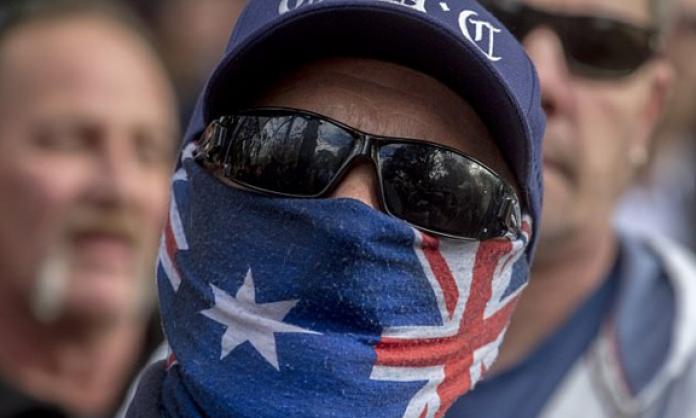Fascists carried out a march in Melbourne on 25 June. Actual fascists. The kind of people who say, “There should be a picture of Hitler in every classroom”. A group that describes itself as “the fist of Australia” and tried to march through multicultural Coburg last year spreading “force and terror”. A group whose Senate candidate lost his gun licence last year after posting pictures of his high-powered automatic rifle and advocating “absolute brutality” to suppress Islam.
The group's leadership calls itself the United Patriots Front. The foot soldiers, it seems, mainly came out of the True Blue Crew, who cut their teeth in street confrontations against migrants and a series of mobilisations against a Muslim school in Melton, in Melbourne’s west, and a mosque in nearby Bendigo. Their most famous supporter, Phillip Galea, is currently awaiting trial on charges of planning to blow up left wing premises.
In recent years, movements like this have mushroomed across the world, each based on some combination of racism, political reaction and street violence.
Now they march through Melbourne.
Thanks to hundreds of police, kindly provided by Daniel Andrews’ Labor government, about a hundred fascists marched from the Exhibition Gardens to Parliament House. Protesters who tried to get in their way were heavily outnumbered by cops, manhandled, kettled and eventually attacked and doused with capsicum spray as we tried to make our way to a dispersal point.
The fascists, by contrast, had the run of the city. After the official protest, around 40 of them were escorted by police as they marched the length of Melbourne’s CBD. Fifteen of them barged into the John Curtin Hotel, opposite Melbourne’s Trades Hall. Though their numbers remain small, this is the first time in many years that fascists have been able to assemble and march freely in inner Melbourne – having tried and failed in Coburg, Richmond, Parliament House and Federation Square in recent years.
It used to be a lot easier than this to stop a fascist march in Melbourne.
When I first moved here in the late 1980s, the fascist group National Action was on the way out. The left and some unionists had mobilised to defend physically left newspaper sellers from fascist attacks in the centre of Melbourne, and made it known that their bovver boy antics wouldn’t be tolerated. NA crumpled and left town.
National Action tried to regain a foothold in the 1990s. In 1994, after a series of racist bashings in the area, NA announced that it was going to march up Sydney Road, Brunswick, in a “white pride” rally. After a bit of postering and leafleting, we got a good thousand or so people to the counter-protest – chanting, shouting and pelting the dozen or so Nazi skinheads with every egg that could be bought from nearby shops and every piece of shit deposited by the police horses. The wannabe master race turned tail and fled, under police guard, onto a city-bound train.
A few years later, NA rented a shop in the working class suburb of Fawkner. The left mobilised again. Though the campaign didn’t rise to any great heights, we had some mobilisations of hundreds – enough to clearly label NA as fascist and to stop it from recruiting. Eventually, it packed up and left town.
A few Nazis crept back in, infesting a pub or two, brawling with each other and bashing migrants and anarchists when they could. But for years, they weren’t game to mount an open, political movement on the streets of Melbourne. In the late 1990s, many far right activists hitched themselves to Pauline Hanson’s racist One Nation Party. But a series of lively demonstrations stopped them from cohering much of a machine.
Today, everything is more difficult.
Successive governments have justified decades of war for oil and empire by stoking anti-Muslim prejudice. It’s not like they have much else to offer us – certainly not decent wages or an easier working life. These wars have produced what the CIA used to call “blowback”: terror attacks that are gleefully seized on by the political right to justify further racism and repression.
Racism against Muslims is widely accepted at all levels of society, much more so than the crude anti-Asian racism that was the stock in trade of racists and fascists in the 1980s and 1990s.
The far right has also learned some lessons. In both France and England, the fascist core of an organisation will often submerge its fascism in a broader movement, and then engage in a series of manoeuvres to harden its supporters – building both a hardened fascist core and a softer periphery it can mobilise.
Meantime, our side hasn’t gotten any stronger. The long term decline of the left and the unions has reduced the number of people who would pretty much automatically turn out to protest against a gang of fascists marching through Melbourne.
It’s clear that all of us are on a learning curve in building the sort of movement and counter-protests we need. It’s also clear that some of our side’s tactics have hurt us. Individuals or groups wearing masks, and the targeting of right wing individuals – such as Herald Sun columnist Andrew Bolt – do nothing to build the open, defiant mass movement that we need to confront fascism.
It only sends a message that our side contains violent thugs with something to hide – a spectacular own goal, and a gift to the mainstream media and the far right.
The problems are real enough, but we should also acknowledge our achievements. Despite everything that the far right has going for it, and some serious mobilisations in regional towns such as Bendigo, it has been unable to build an ongoing mass movement.
Our side’s mobilisations have been important in this. By clearly labelling its leaders as fascists, we make it harder for them to portray themselves as “ordinary Australians”. By drowning out its message of racism and hate with a message of struggle and solidarity, we cut away some of the fascists’ softer support. By not letting fascist goons goose-step through Melbourne without opposition, we put pressure on their organisation.
The Campaign Against Racism and Fascism is one of several groups planning to continue this work of counter-protests, as well as trying to create a broader awareness of the threat of the far right, which can feed into future counter-mobilisations.
Fascists marched through our town on the weekend.
Things just got more serious.
For more information about the anti-fascist campaign, visit www.facebook.com/campaignarf









